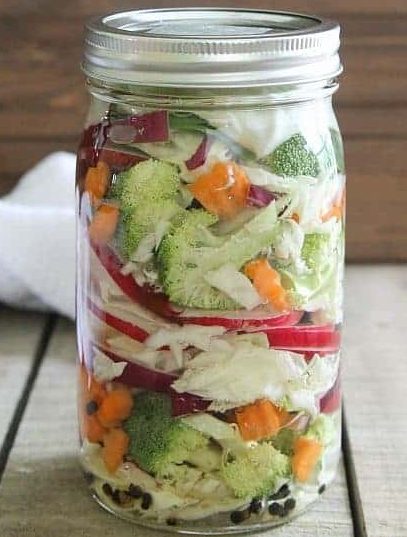The Ultimate Guide to Lacto-Fermenting Vegetables at Home
Mastering the Art of Lacto-Fermentation
Lacto-fermentation is a simple yet transformative technique that not only enhances the flavor of your vegetables but also boosts their nutritional value. This age-old process relies on the natural action of beneficial bacteria to ferment sugars into lactic acid, preserving the vegetables while creating tangy and complex flavors. This guide walks you through everything you need to know about making your own lacto-fermented vegetables in a mason jar, perfect for beginners and seasoned fermenters alike.
What is Lacto-Fermentation?
Lacto-fermentation is a natural process in which lactic acid bacteria (LAB) convert sugars in vegetables into lactic acid. This process preserves the vegetables, gives them their characteristic tangy flavor, and enhances their probiotic content. Unlike vinegar-based pickling, lacto-fermentation doesn’t require heat, making it a raw food preservation method that retains the nutrients of the vegetables.
Why Should You Lacto-Ferment Vegetables?
Health Benefits: Lacto-fermented vegetables are rich in probiotics, which support gut health, boost immunity, and improve digestion.
Enhanced Flavor: The natural fermentation process creates complex, tangy flavors that are a delight to the palate.
Easy and Inexpensive: With just a few simple ingredients—vegetables, salt, water, and optional spices—you can make your own fermented creations at home.
Preservation: Fermented vegetables have an extended shelf life, allowing you to enjoy seasonal produce year-round.
Choosing Your Vegetables
One of the beauties of lacto-fermentation is its versatility. You can ferment almost any vegetable, either individually or in combinations. Here are some popular choices:
Carrots: Sweet and crunchy, they ferment beautifully.
Radishes: Add a peppery zing to your mix.
Broccoli: Offers a unique texture and earthy flavor.
Cabbage: The star of sauerkraut, cabbage is a staple in fermentation.
Essential Equipment and Ingredients
Before you get started, gather the following:
Wide-mouth Mason Jars: A quart-sized jar works well for small batches. Choose jars with plastic lids to avoid corrosion from acidity.
Vegetables: Fresh and organic options are best.
Coarse Sea Salt: Avoid iodized salt, as it can interfere with fermentation.
Water: Filtered or distilled water is ideal to avoid chlorine and other chemicals that might inhibit fermentation.
Spices and Herbs: Customize your ferment with additions like peppercorns, dill, basil, bay leaves, or garlic.
Cabbage Leaf: A small leaf can act as a weight to keep the vegetables submerged (optional but helpful).
Understanding the Brine Ratio
The magic of lacto-fermentation lies in the saltwater brine. A common ratio is 1.5 tablespoons of coarse sea salt per 2 cups of water. This creates the ideal environment for beneficial bacteria while discouraging harmful microbes.
Preparing for Fermentation
Cleanliness is Key: Wash your jars, lids, and utensils with hot, soapy water. Rinse well to avoid soap residue.
Prep Your Veggies: Slice, chop, or shred vegetables uniformly to ensure even fermentation. Smaller pieces ferment faster.
Mix the Brine: Dissolve the salt completely in water, stirring until the solution is clear.
Creating the Perfect Fermentation Environment
Fermentation works best at a moderate room temperature of 68-75°F. Keep jars out of direct sunlight to avoid overheating. As fermentation progresses, you’ll notice bubbling and cloudiness—both are signs of active fermentation.
Troubleshooting Common Fermentation Issues
Floating Vegetables: Use a cabbage leaf or fermentation weight to keep vegetables submerged.
White Film: A harmless yeast called kahm yeast may form. Simply skim it off.
Mold: If mold appears, it’s usually due to vegetables being exposed to air. Discard the batch and start fresh.
Lacto-Fermented Vegetables
Ingredients:
Fresh vegetables (carrots, radishes, broccoli, or your favorites)
2 cups of filtered water
1 1/2 tablespoons coarse sea salt
Spices and herbs (optional: dill, garlic, peppercorns, or bay leaves)
1 small cabbage leaf (optional)
1 quart-sized wide-mouth Mason jar with a plastic lid
Instructions:
Prepare the Jar: Pack your vegetables and any chosen spices/herbs into the Mason jar. Leave about 1 inch of space below the rim.
Make the Brine: In a separate container, stir the salt into the water until fully dissolved.
Add the Brine: Pour the saltwater solution over the vegetables, ensuring they are completely submerged. Leave about 1/2 inch of space at the top of the jar.
Secure the Vegetables: Use a folded cabbage leaf to press the vegetables below the brine level. This step is optional but helps maintain full submersion.
Seal and Store: Close the jar tightly and store it at room temperature, away from direct sunlight.
Monitor and Release Gas: After 2 days, check for bubbles. Loosen the lid slightly over a sink to release built-up gas, then reseal. Repeat daily.
Taste Test: Start tasting the vegetables on day 4. Continue until they reach your desired tanginess, typically around day 5 or 6.
Refrigerate: Once the fermentation is complete, transfer the jar to the refrigerator. The vegetables will keep for several months.
